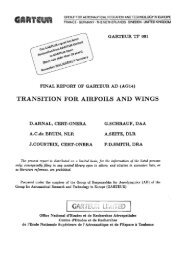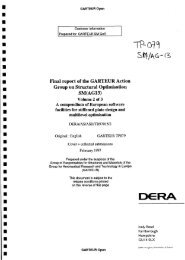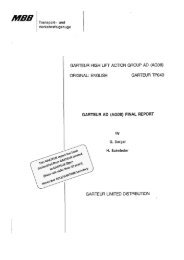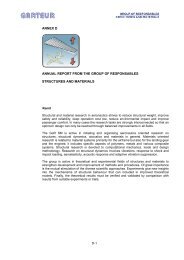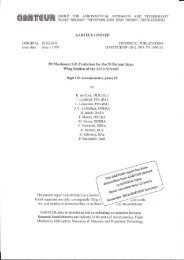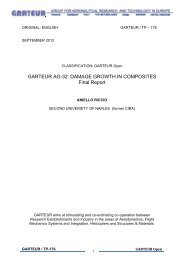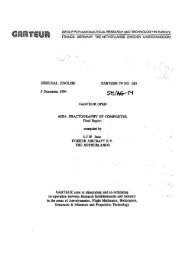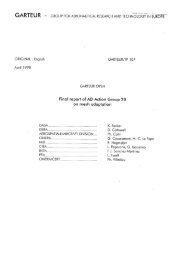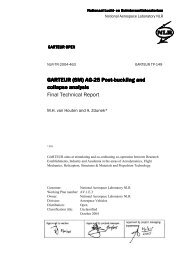Cadmium Substitution - garteur
Cadmium Substitution - garteur
Cadmium Substitution - garteur
Create successful ePaper yourself
Turn your PDF publications into a flip-book with our unique Google optimized e-Paper software.
GARTEUR LIMITED<br />
show that in each case the ED zinc-cobalt-iron coatings gave the greatest degree of<br />
protection in the scribed region overall equalling the performance of ED cadmium. The<br />
ED zinc-nickel was not so effective. As indicated in Annex C, rusting was found in the<br />
scribe areas of all the zinc-nickel coated panels tested at the three outdoor exposure<br />
sites. Delta-tone coatings were exposed at two of the sites and were found to compare<br />
favourably with ED cadmium plating. The pure aluminium coatings and the SermeTel<br />
coatings were the least effective and gave a level of protection well below that found for<br />
cadmium plating.<br />
The results obtained under outdoor exposure conditions are consistent with the electrochemical<br />
measurements reported in section 4.2.1 above which showed that the zinc<br />
based coatings were more effective as sacrificial coatings than the aluminium based<br />
systems.<br />
4.2.4 Conclusions<br />
1. The aluminium based coatings were found to have superior barrier properties to the<br />
zinc rich deposits<br />
2. Electrochemical and accelerated corrosion tests have demonstrated that the zinc<br />
rich deposits are more effective in preventing the onset of rusting at scratches or defects<br />
in the coating than the aluminium and aluminium alloy coatings.<br />
4.3 Galvanic compatibility<br />
Two methods have been employed to study the galvanic compatibility between the<br />
coatings and aerospace aluminium alloys. In the first coated bolts have been inserted<br />
into aluminium alloy blocks and exposed to a corrosive environment. Research at DBAA<br />
used exposure to neutral salt fog whilst at Fokker test blocks were also placed on test at<br />
the Schiphol outdoor exposure site. The second method employed directly measured<br />
the galvanic current generated when a coated sample was connected to an aluminium<br />
alloy panel.<br />
4.3.1 Corrosion tests on bolt/block specimens<br />
Results of the neutral salt fog tests on bolt/block specimens indicated that several<br />
coatings caused less dissimilar metal corrosion than cadmium plating. The results of the<br />
salt spray tests based on the data given in Annex D are summarised in table 9.<br />
4.3.2 Electrochemical studies<br />
Galvanic compatibility tests were carried out on coated panels electrically connected to<br />
aluminium alloy coupons and immersed in 600mmol/litre sodium chloride solution for 168<br />
hours. The galvanic corrosion current generated was monitored throughout the test and<br />
the mean corrosion current calculated. The effect of different coatings on the corrosion<br />
rate of the aluminium alloys was also determined by measuring the weightloss of the<br />
aluminium alloy coupons used in the galvanic corrosion tests. The values obtained were<br />
compared with weightloss measurements made on uncoupled test coupons.<br />
4.3.3 Galvanic corrosion current measurements<br />
From the galvanic corrosion current measurements, two types of behaviour were<br />
observed. For the as plated zinc based coatings (ED zinc-nickel, ED zinc-cobalt-iron and<br />
Delta-tone) the galvanic corrosion current recorded initially was high but fell during the<br />
168 hour monitoring period. In the case of the ED zinc-nickel coating, current reversal<br />
occurred and is associated with de-zincification of the coating. The passivated zinc alloy<br />
GARTEUR SM/AG17 TP128 Page 11




